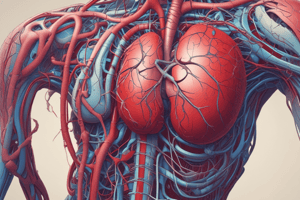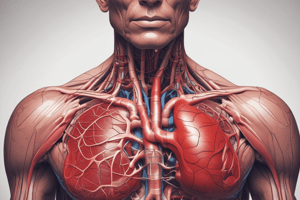Podcast
Questions and Answers
Which of the following substances is primarily found in the blood and plays a significant role in maintaining osmotic pressure?
Which of the following substances is primarily found in the blood and plays a significant role in maintaining osmotic pressure?
- Albumin (correct)
- Water
- Urea
- Glucose
What directly increases blood viscosity in the human body?
What directly increases blood viscosity in the human body?
- Increased body weight
- Increased serum plasma volume
- Increased hematocrit (correct)
- Increased muscle mass
What type of junctions primarily exist between the endothelial cells of capillaries?
What type of junctions primarily exist between the endothelial cells of capillaries?
- Tight junctions (correct)
- Adherens junctions
- Gap junctions
- Desmosomes
Which of the following substances is NOT typically measured as a parameter of the blood’s perfusion capacity?
Which of the following substances is NOT typically measured as a parameter of the blood’s perfusion capacity?
Which physiological process would be least affected by a change in serum plasma volume?
Which physiological process would be least affected by a change in serum plasma volume?
Which substance acts as a natural anticoagulant in the bloodstream?
Which substance acts as a natural anticoagulant in the bloodstream?
What do fibrin fibers primarily contribute to during clotting?
What do fibrin fibers primarily contribute to during clotting?
Which of the following statements accurately describes the endothelial cell surface?
Which of the following statements accurately describes the endothelial cell surface?
Which factor is essential for breaking down fibrin during the clot dissolution process?
Which factor is essential for breaking down fibrin during the clot dissolution process?
In the context of the immune system, what typically constitutes the last line of defense against infection?
In the context of the immune system, what typically constitutes the last line of defense against infection?
Which nerve innervates the esophagus and is part of the vagus nerve system?
Which nerve innervates the esophagus and is part of the vagus nerve system?
What is the primary responsibility of the right recurrent laryngeal nerve?
What is the primary responsibility of the right recurrent laryngeal nerve?
Which nerve is associated with both voluntary and involuntary control of the organs within the thoracic cavity?
Which nerve is associated with both voluntary and involuntary control of the organs within the thoracic cavity?
In which anatomical region does the right recurrent laryngeal nerve take its path?
In which anatomical region does the right recurrent laryngeal nerve take its path?
What is a common clinical manifestation of damage to the recurrent laryngeal nerves?
What is a common clinical manifestation of damage to the recurrent laryngeal nerves?
Which structure receives deoxygenated blood from the body?
Which structure receives deoxygenated blood from the body?
What is the primary function of the left ventricle in the heart?
What is the primary function of the left ventricle in the heart?
Which structure separates the left atrium from the left ventricle?
Which structure separates the left atrium from the left ventricle?
In which anatomical space would you find the apex of the heart?
In which anatomical space would you find the apex of the heart?
Which chamber of the heart has the thickest muscular wall?
Which chamber of the heart has the thickest muscular wall?
Which of the following antibodies is known for its pentameric structure?
Which of the following antibodies is known for its pentameric structure?
Which artery does NOT arise from the internal thoracic artery?
Which artery does NOT arise from the internal thoracic artery?
What is the significance of the 2nd left intercostal space in a clinical examination?
What is the significance of the 2nd left intercostal space in a clinical examination?
Which of these statements about intercostal spaces is true?
Which of these statements about intercostal spaces is true?
What structure is typically located in the 6th right intercostal space?
What structure is typically located in the 6th right intercostal space?
What process does opsonization specifically refer to?
What process does opsonization specifically refer to?
Which cell type is NOT directly involved in the opsonization process?
Which cell type is NOT directly involved in the opsonization process?
How are pathogens targeted for destruction during opsonization?
How are pathogens targeted for destruction during opsonization?
What is the primary cellular response involved in inflammation that allows for the movement of immune cells?
What is the primary cellular response involved in inflammation that allows for the movement of immune cells?
In which form is the least amount of iron found in the human body?
In which form is the least amount of iron found in the human body?
Flashcards
Blood viscosity increase
Blood viscosity increase
Increased hematocrit directly increases blood's thickness (viscosity).
Blood components
Blood components
Albumin, glucose, urea, and water are crucial components of blood.
Capillary junctions
Capillary junctions
Tight junctions mainly make up the junctions between endothelial cells in capillaries.
Location of tight junctions
Location of tight junctions
Signup and view all the flashcards
Hematocrit and viscosity
Hematocrit and viscosity
Signup and view all the flashcards
Reticulocyte
Reticulocyte
Signup and view all the flashcards
Opsonization
Opsonization
Signup and view all the flashcards
CFU-B
CFU-B
Signup and view all the flashcards
CFU-S
CFU-S
Signup and view all the flashcards
Proerythroblast
Proerythroblast
Signup and view all the flashcards
Smooth endothelial surface
Smooth endothelial surface
Signup and view all the flashcards
Plasmin
Plasmin
Signup and view all the flashcards
Heparin
Heparin
Signup and view all the flashcards
Fibrin fibers
Fibrin fibers
Signup and view all the flashcards
Last line of defense against infection
Last line of defense against infection
Signup and view all the flashcards
Esophagus
Esophagus
Signup and view all the flashcards
Right Vagus Nerve
Right Vagus Nerve
Signup and view all the flashcards
Right Recurrent Laryngeal Nerve
Right Recurrent Laryngeal Nerve
Signup and view all the flashcards
Left Vagus Nerve
Left Vagus Nerve
Signup and view all the flashcards
Vertebral canal
Vertebral canal
Signup and view all the flashcards
Right atrium
Right atrium
Signup and view all the flashcards
Right ventricle
Right ventricle
Signup and view all the flashcards
Left atrium
Left atrium
Signup and view all the flashcards
Left ventricle
Left ventricle
Signup and view all the flashcards
Pentamere structure
Pentamere structure
Signup and view all the flashcards
Internal thoracic artery branches
Internal thoracic artery branches
Signup and view all the flashcards
Anterior intercostal arteries
Anterior intercostal arteries
Signup and view all the flashcards
Musculophrenic artery
Musculophrenic artery
Signup and view all the flashcards
Superior epigastric artery
Superior epigastric artery
Signup and view all the flashcards
Pericardium
Pericardium
Signup and view all the flashcards
Study Notes
Circulatory Physiology
- Arteries transport blood under high pressure to tissues.
- Veins collect blood from capillaries, merging into larger veins.
- Capillary hydrostatic pressure forces fluid & dissolved substances into interstitial spaces.
- Approximate average net filtration pressure of capillaries is about 20 mmHg.
- Arterioles are the smallest arterial branches, controlling blood flow.
Blood Flow in Circulation
- Overall blood flow in adult rest is about 5000 ml/min.
- Albumin has less permeability compared to other molecules like glucose and water.
- Increasing hematocrit directly increases blood viscosity.
- Tight junctions are found between capillary endothelial cells in the kidney, spleen, liver, and brain.
Blood Reservoirs and Blood Flow Rate
- Edema in legs may be a symptom in people standing long periods with varicose veins.
- Rate of blood flow through the entire circulatory system equals cardiac output.
- Inhibition of sympathetic activity dilates blood vessels and increase blood flow.
- In aortic valve stenosis, aortic pressure pulse is significantly decreased.
Colloid Osmotic Pressure
- Albumin plays a significant role in colloid osmotic pressure.
- The aortic arc baroreceptors send signals to the vasomotor center through the vagus and glossopharyngeal nerves.
Hematocrit
- Hematocrit is elevated above normal range in polycythemia.
- The brain's vasomotor center controls vasoconstriction.
Blood Flow, Blood Pressure, and other factors
- Based on Ohm's law, higher pressure difference leads to increased blood flow.
Blood Cells and Components
- Proerythroblast is the first cell identified in the RBC series.
- Opsonization involves a process where pathogens are marked for phagocytosis.
- Iron in the human body is minimally present as ferritin.
- Leukemic cells often show metastatic growth in abnormal body areas.
Blood Clotting
- Thrombin does not directly affect factor VI.
Studying That Suits You
Use AI to generate personalized quizzes and flashcards to suit your learning preferences.




